The museum is home to millions of objects and images that trace the history of photography. This post is the second in an alphabetical journey that will explore varied aspects of our world-class collection—B is for… Brownie.
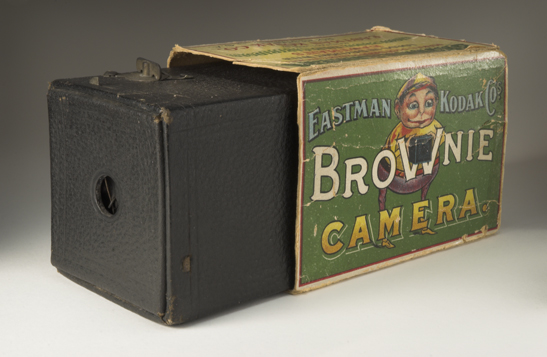
The humble box Brownie can justifiably claim to be the camera of the 20th century. Generations of snapshooters used their Brownies to create a photographic record of their lives. Many famous photographers, too, acknowledge that their first interest in photography can be traced back to being given a Brownie camera as a child. Just as the adverts said;
Plant the Brownie acorn and the Kodak oak will grow.
Countless millions of Brownie cameras were sold. Such was their popularity that all box cameras, whoever their manufacturer, were commonly known as Brownies. It is the camera that democratised photography.
Minimum costs with maximum return—the launch of the very first Brownie camera
In 1898, George Eastman, the founder of Kodak, asked his camera designer, Frank Brownell, to design a camera that would be as cheap as possible while still being capable of taking successful photographs.
Eastman was determined to bring photography within reach of everyone—not through altruism but for sound business reasons. All those who could be persuaded to take up photography were potential users of Kodak film, already identified as the major source of Kodak’s profits.

Brownell came up with his simplest but most influential design, keeping costs to an absolute minimum through the use of cheap materials and mass production techniques.
The new camera was launched in February 1900. It was a small box, measuring just five inches long, three inches high, and three inches wide, made from jute-board reinforced with wood and covered with imitation leather.
It had a simple rotary shutter for time and instantaneous exposures and an f/14 meniscus lens. Like the first Kodak camera, there was no viewfinder but a clip-on viewfinder was available as an optional extra. Six 2 ¼ inch square negatives could be taken on what was later designated 117 roll film.
Palmer Cox-inspired illustrations appeal to a young audience
Eastman named his new camera ‘The Brownie’—not after Frank Brownell, but after characters created by the popular Canadian children’s author and illustrator, Palmer Cox.
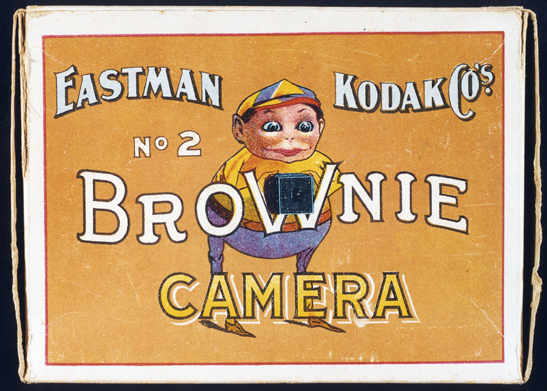
Eastman, always the shrewd businessman, wanted to cash in on their popularity and make the camera more appealing to children. At first, Brownie packaging carried illustrations of the little, pixie-like characters. It soon became clear, however, that the cameras were not being bought by parents for their children but for them to use themselves.
Good value, reliable, and available to everyone—80 years of the Brownie camera
The Brownie characters soon disappeared but the name stuck. The Brownie was aimed at people who had no previous experience of photography and was widely advertised in the popular press.
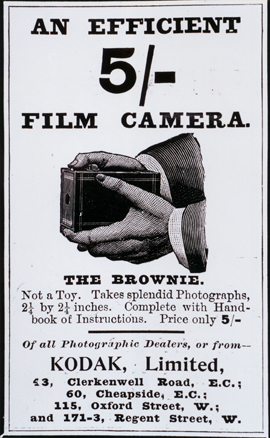
In Britain it cost just 5 shillings (25p), bringing it within the reach of practically everyone. Indeed, it was so cheap that adverts had to reinforce the fact that it wasn’t a toy.
Good value, reliable and capable of perfectly satisfactory results in the right conditions, the Brownie was an instant success.
Within a year, over 100,000 had been sold. Other Brownies soon followed. As well as Box Brownies, there were Folding Brownies and even a Stereo Brownie. The name ‘Brownie’ soon became synonymous with popular photography.
The very last Brownie camera—a 110 cartridge camera—appeared in 1980. By that time, nearly 100 different cameras had carried the famous name.
This is an edited version of an article which first appeared in Black+White Photography magazine in January 2009.
Items related to the Brownie camera in our collection
Our collection contains examples of nearly every model of Brownie camera. Here is a small selection:
Further reading and interesting links
- The Brownie Camera page
- The Brownie Camera page’s YouTube channel
- Wayne Morgan, ‘Palmer Cox, the Brownie Craze and the Brownie Camera’, The Photographic Historical Society of Canada, March 2007
- Eaton S. Lothrop Jr, The Brownie Camera, History of Photography, Volume 2, Number 1, January 1978
- Brian Coe, Kodak Cameras: The First Hundred Years, Hove: Hove Foto Books, 1988
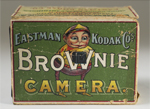
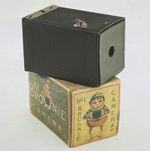
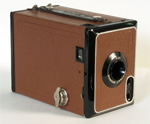

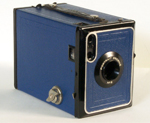

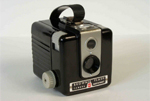

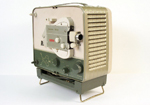


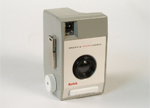
Beautiful cameras there. What people don’t realise is that a lot of Brownie style cameras can be picked up for very little – and can still be used today. OK, the film, processing and scanning aren’t cheap, and you need a lot of light, but given all that you can still get some beautiful images out of them.